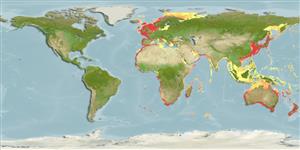>
Zeiformes (Dories) >
Zeidae (Dories)
Etymology: Zeus: Derived from Greek Theos, Zeys = the supreme Greek god (Ref. 45335).
More on author: Linnaeus.
Environment: milieu / climate zone / depth range / distribution range
Ekologi
marina; brackvatten bentopelagisk; havsvandrande (Ref. 35388); djupintervall 5 - 400 m (Ref. 9563), usually 50 - 150 m (Ref. 4968). Temperate; 75°N - 49°S, 17°W - 177°E (Ref. 54935)
Worldwide in distribution. Eastern Atlantic: Norway to South Africa, also the Mediterranean and Black Sea. Western Pacific: Japan, Korea, Australia and New Zealand. Also known from the Indian Ocean.
Length at first maturity / Size / Vikt / Age
Maturity: Lm 35.1, range 29 - 35 cm
Max length : 90.0 cm TL hane/ej könsbestämd; (Ref. 6953); common length : 40.0 cm TL hane/ej könsbestämd; (Ref. 6953); publicerad maxvikt: 8.0 kg (Ref. 35388); rapporterad maxålder: 12 år (Ref. 5377)
Taggstrålar i ryggfenan (totalt): 9 - 11; Mjukstrålar i ryggfenan (totalt): 22-24; Taggstrålar i analfenan 4; Mjukstrålar i analfenan: 20 - 23. Gill rakers rudimentary. Minute scales present. Highly compressed body (Ref. 4253). Large dark spot, surrounded by a light ring on each side of the body (Ref. 35388).
Found in areas close to the sea bed (Ref. 6390). Generally solitary. Feeds mainly on schooling bony fishes, occasionally on cephalopods and crustaceans (Ref. 27121). Reproduction takes place at the end of winter and at the start of spring in the northeastern Atlantic, earlier in the Mediterranean. Eggs are pelagic, maturity reached at 4 years (Ref. 36731). Sold fresh (Ref. 9563) and frozen (Ref. 9988). Can be steamed, fried, broiled, boiled, microwaved and baked (Ref. 9988). The flesh is excellent but is utilized little in West Africa (Ref. 5377).
No studies of their reproductive development or early life history have been undertaken in Australia (Ref. 6390). Pelagic eggs (Ref. 35388).
Karrer, C. and A. Post, 1990. Zeidae. p. 631-633. In J.C. Quero, J.C. Hureau, C. Karrer, A. Post and L. Saldanha (eds.) Check-list of the fishes of the eastern tropical Atlantic (CLOFETA). JNICT, Lisbon; SEI, Paris; and UNESCO, Paris. Vol. 2. (Ref. 6953)
IUCN Red List Status (Ref. 130435)
Threat to humans
Harmless
Human uses
Can't connect to MySQL database (fbapp). Errorcode: Too many connections
